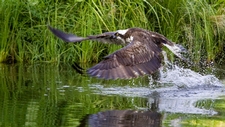Food Chains and Webs
Readiness

TEKS Objective
The student is expected to describe how the flow of energy derived from the Sun, used by producers to create their own food, is transferred through a food chain and food web to consumers and decomposers.
Essential Understanding
The student knows that there are relationships, systems, and cycles within environments.
Science Background
Food Chains and Food Webs: World Wildlife Fund (website) - Description and background information about food chains, food webs and the flow of energy and nutrients through an ecosystem. Includes links to much more information about related topics.
Food Chains and Food Webs
World Wildlife Fund, wwf.panda.org
Food Web Background: NY Sea Grant (website) - Within an ecosystem, each food web consists of many food chains. Download the “Background” PDF files on this page to learn much more about different aquatic ecosystems and the organisms that inhabit them.
Signature Lesson
Who’s Eating Whom? University of Michigan (PDF) - Students simulate the feeding habits of freshwater organisms and demonstrate the interconnectedness of, and transfer of energy through a food web. They learn and describe the similarities and differences between food webs and food chains, understand predator/prey and consumer/producer relationships, and observe how energy is transferred from producers to consumers and decomposers.
Who’s Eating Whom?
University of Michigan, www.miseagrant.umich.edu
- Supporting Lessons
- Extensions
- Assessment Ideas
- Literature Connections
- Related
TEKS - Additional Resources
Supporting Lessons
Food Webs: BioEd Online (website) - Students learn about producers, consumers and the interactions between them while constructing and describing possible food webs for six different ecosystems.
Food Webs
BioEd Online, www.bioedonline.org
Web of Life: Texas A&M University (website) - Students discover how insects contribute to food webs, and use yarn to create a classroom “food web” that illustrates the roles of different ecosystems, animals and insects in the web of life.
Web of Life
Texas A&M University, iitc.tamu.edu
Arctic Food Chain: World Wildlife Fund (website) - Students learn about food chains, with particular emphasis on the importance of Arctic food chains. Includes extensions and downloadable student worksheets.
Elaboration Lessons and Extensions
Food Webs: My Science Box (website) - In this two- to three-day activity, students choose an organism from a designated ecosystem, conduct independent research on its life cycle, food chain and habitat, and use the information collected to collaboratively build a food web that describes how energy is transferred.
Food Webs
My Science Box, mysciencebox.org
Striking a Balance: US Department of Agriculture (PDF) - The sun’s energy is captured by individual plants and transferred to animals through food chains. In this activity, students learn the principles and dynamics of food chains by assuming roles, playing tag and simulating feeding relationships.
Striking a Balance
US Department of Agriculture, www.agclassroom.org
Assessment Ideas
Food Chain Card Games: Virtual Teacher Aide (website) - Print out Food Chain cards for the different habitats. Ask students to use the detailed information provided on each card to build a food web including all components of one or more habitats.
Literature Connections
Food Chains and Webs. Delta Education (ISBN-13: 978-1592422579)
Exploring Ecosystems with Max Axiom, Super Scientist. Biskup, Agnieszka (ISBN-13: 978-1429611565)
Who Eats What? Food Chains and Food Webs. Lauber, P. and Keller, H. (ISBN-13: 978-0064451307)
The World of Food Chains with Max Axiom, Super Scientist. O’Donnell, Liam (ISBN-13: 978-0736868396)
Food Webs: Interconnecting Food Chains. Gray, Susan (ISBN-13: 978-0756532611)
Pass the Energy, Please! Shaw McKinney. Barbara (ISBN-13: 978-1584690016)
What Are Food Chains and Food Webs? Vogel, Julia (ISBN-13: 978-1602707962)
The Food Web of a Tropical Rain Forest. Reagan D.P. and Waide R.B. (ISBN-13: 978-0226706009)
Additional Resources
Create A Food Web: Virtual Teacher Aide (website) - Information about food webs, with links to information and illustrations that show how energy flows from producers to consumers in a variety of environments (desert, coniferous forest, temperate rainforest, etc.). Click on “Create a food web” for an interactive activity in which students create a food web using clip art images and arrows showing energy flow from producers to consumers.
Create A Food Web
Virtual Teacher Aide, www.vtaide.com
The Food Chain Game: Sheppard Software (website) - Student drag components of the food chain into the correct position and then watch as the parts become animated in this engaging interactive game
The Food Chain Game
Sheppard Software, www.sheppardsoftware.com
Whales and Food Webs: Cool Antarctica (website) - Learn about Antarctic whales, the Antarctic Ocean food web, and the transfer of energy in the Antarctic food chain.
Whales and Food Webs
Cool Antarctica, www.coolantarctica.com
Another Link in the Food Chain: Geography4Kids (website) - Quick review of the major components of food chains, along with an explanation of producers, consumers and decomposers, and their interactions.
Another Link in the Food Chain
Geography4Kids, www.geography4kids.com
TEKS Navigation
Grade 5
User Information
Not Registered Yet?
Sign Up Today!
Need Assistance?
If you need help or have a question please use the links below to help resolve your problem.

Comments